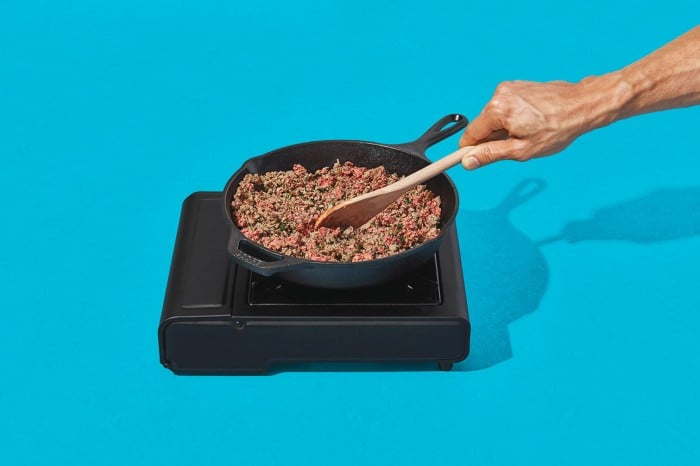The race to make a lab-grown steak
Meat production spews tons of greenhouse gas and uses up too much land and water. Is there an alternative that won’t make us do without?

In 2013, the world’s first burger from a lab was cooked in butter and eaten at a glitzy press conference. The burger cost £215,000 ($330,000 at the time) to make, and despite all the media razzmatazz, the tasters were polite but not overly impressed. “Close to meat, but not that juicy,” said one food critic.
Still, that one burger, paid for by Google cofounder Sergey Brin, was the earliest use of a technique called cellular agriculture to make edible meat products from scratch—no dead animals required. Cellular agriculture, whose products are known as cultured or lab-grown meat, builds up muscle tissue from a handful of cells taken from an animal. These cells are then nurtured on a scaffold in a bioreactor and fed with a special nutrient broth.
A little over five years later, startups around the world are racing to produce lab-grown meat that tastes as good as the traditional kind and costs about as much.
They’re already playing catch-up: “plant-based” meat, made of a mix of non-animal products that mimic the taste and texture of real meat, is already on the market. The biggest name in this area: Impossible Foods, whose faux meat sells in more than 5,000 restaurants and fast food chains in the US and Asia and should be in supermarkets later this year. Impossible’s research team of more than 100 scientists and engineers uses techniques such as gas chromatography and mass spectrometry to identify the volatile molecules released when meat is cooked.
The key to their particular formula is the oxygen-carrying molecule heme, which contains iron that gives meat its color and metallic tang. Instead of using meat, Impossible uses genetically modified yeast to make a version of heme that is found in the roots of certain plants.
Impossible has a few competitors, particularly Beyond Meat, which uses pea protein (among other ingredients) to replicate ground beef. Its product is sold in supermarket chains like Tesco in the UK and Whole Foods in the US, alongside real meat and chicken. Both Impossible and Beyond released new, improved versions of their burgers in mid-January.
In contrast, none of the lab-grown-meat startups has yet announced a launch date for its first commercial product. But when that happens—some claim as early as the end of this year—the lab-grown approach could turn the traditional meat industry on its head.
“I suspect that cultured meat proteins can do things that plant-based proteins can’t in terms of flavor, nutrition, and performance,” says Isha Datar, who leads New Harvest, an organization that helps fund research in cellular agriculture. Datar, a cell biologist and a fellow at the MIT Media Lab, believes cultured meats will more closely resemble real meat, nutritionally and functionally, than the plant-based kinds do. The idea is that a die-hard carnivore (like me) might not feel so put off at the thought of giving up the real thing.
A global risk

You might ask, why would anyone want to? The answer is that our meat consumption habits are, in a very literal sense, not sustainable.
Livestock raised for food already contribute about 15% of the world’s global greenhouse-gas emissions. (You may have heard that if cows were a country, it would be the world’s third biggest emitter.) A quarter of the planet’s ice-free land is used to graze them, and a third of all cropland is used to grow food for them. A growing population will make things worse. It’s estimated that with the population expected to rise to 10 billion, humans will eat 70% more meat by 2050. Greenhouse gases from food production will rise by as much as 92%.
In January a commission of 37 scientists reported in The Lancet that meat’s damaging effects not only on the environment but also on our health make it “a global risk to people and the planet.” In October 2018 a study in Nature found that we will need to change our diets significantly if we’re not to irreparably wreck our planet’s natural resources.
“Without changes toward more plant-based diets,” says Marco Springmann, a researcher in environmental sustainability at the University of Oxford and the lead author of the Nature paper, “there is little chance to avoid dangerous levels of climate change.”
The good news is that a growing number of people now seem to be rethinking what they eat. A recent report from Nielsen found that sales of plant-based foods intended to replace animal products were up 20% in 2018 compared with a year earlier. Veganism, which eschews not just meat but products that come from greenhouse-gas-emitting dairy livestock too, is now considered relatively mainstream.
That doesn’t necessarily equate to more vegans. A recent Gallup poll found that the number of people in the US who say they are vegan has barely changed since 2012 and stands at around just 3%. Regardless, Americans are eating less meat, even if they’re not cutting it out altogether.
And now for the lawsuits

Investors are betting big that this momentum will continue. Startups such as MosaMeat (cofounded by Mark Post, the scientist behind the £215,000 burger), Memphis Meats, Supermeat, Just, and Finless Foods have all swept up healthy sums of venture capital. The race now is to be first to market with a palatable product at an acceptable cost.
Memphis Meats’ VP of product and regulation, Eric Schulze, sees his product as complementing the real-meat industry. “In our rich cultural tapestry as a species, we are providing a new innovation to weave into our growing list of sustainable food traditions,” he says. “We see ourselves as an ‘and,’ not ‘or,’ solution to helping feed a growing world.”
The traditional meat industry doesn’t see it that way. The National Cattlemen’s Beef Association in the US dismissively dubs these new approaches “fake meat.” In August 2018, Missouri enacted a law that bans labeling any such alternative products as meat. Only food that has been “derived from harvested production of livestock or poultry” can have the word “meat” on the label in any form. Breaking that law could lead to a fine or even a year’s jail time.
The alternative-meat industry is fighting back. The Good Food Institute, which campaigns for regulations that favor plant-based and lab-grown meats, has joined forces with Tofurky (the makers of a tofu-based meat replacement since the 1980s), the American Civil Liberties Union, and the Animal Legal Defense Fund to get the law overturned. Jessica Almy, the institute’s policy director, says the law as it stands is “nonsensical” and an “affront” to the principle of free speech. “The thinking behind the law is to make plant-based meat less appealing and to disadvantage cultured meat when it comes on the market,” she says.
Almy says she’s confident their case will be successful and is expecting a temporary injunction to be granted soon. But the Missouri battle is just the start of a struggle that could last years. In February 2018, the US Cattlemen’s Association launched a petition that calls on the US Department of Agriculture (USDA) to enact a similar federal law.
We’ll need to change our diets to avoid wrecking the planet.
Traditional meat-industry groups have also been very vocal on how cultured meat and plant-based meats are to be regulated. Last summer a group of the biggest agricultural organizations in the US (nicknamed “The Barnyard”) wrote to President Trump asking for reassurance that the USDA will oversee cultured meat to ensure “a level playing field.” (The USDA has tougher, more stringent safety inspections than the Food and Drug Administration.)
In November 2018, the USDA and the FDA finally released a joint statement to announce that the two regulators would share the responsibilities for overseeing lab-grown meats.
The bovine serum problem
Some cultured-meat startups say this confusion over regulations is the only thing holding them back. One firm, Just, says it plans to launch a ground “chicken” product this year and has trumpeted a partnership with a Japanese livestock firm to produce a “Wagyu beef” product made from cells in the lab. Its CEO is Josh Tetrick, who’d previously founded the controversial startup Hampton Creek, Just’s forebear. (The FDA had at one time banned the firm from calling its signature product mayonnaise, as it did not contain any eggs.) Speak to Tetrick, a bullish, confident young man, and you get a sense of the drive and excitement behind the alternative-meat market. “The only [limit] to launching,” he says, “is regulatory.”

That’s optimistic, to say the least. The lab-meat movement still faces big technical hurdles. One is that making the product requires something called fetal bovine serum. FBS is harvested from fetuses taken from pregnant cows during slaughter. That’s an obvious problem for a purportedly cruelty-free product. FBS also happens to be eye-wateringly expensive. It is used in the biopharmaceutical industry and in basic cellular research, but only in tiny amounts. Cultured meat, however, requires vast quantities. All the lab-meat startups will have to use less of it—or eliminate it completely—to make their products cheap enough. Last year Finless Foods (which aims to make a fish-free version of bluefin tuna) reported that it had halved the amount of FBS it needs to grow its cells. And Schulze says the Memphis Meats team is working on ways of cutting it out entirely.
But there are other issues, says Datar, of New Harvest. She says we still don’t understand the fundamental processes well enough. While we have quite a deep understanding of animals used in medical research, such as lab mice, our knowledge of agricultural animals at a cellular level is rather thin. “I’m seeing a lot of excitement and VCs investing but not seeing a lot in scientific, material advancements,” she says. It’s going to be tricky to scale up the technology if we’re still learning how these complex biological systems react and grow.
Lab-grown meat has another—more tangible—problem. Growing muscle cells from scratch creates pure meat tissue, but the result lacks a vital component of any burger or steak: fat. Fat is what gives meat its flavor and moisture, and its texture is hard to replicate. Plant-based meats are already getting around the problem—to some extent—by using shear cell technology that forces the plant protein mixture into layers to produce a fibrous meat-like texture. But if you want to create a meat-free “steak” from scratch, some more work needs to be done. Cultured meat will need a way to grow fat cells and somehow mesh them with the muscle cells for the end result to be palatable. That has proved tricky so far, which is the main reason that first burger was so mouth-puckeringly dry.
The scientists at the Netherlands-based cultured-meat startup Meatable might have found a way. The team has piggybacked on medical stem-cell research to find a way of isolating pluripotent stem cells in cows by taking them from the blood in umbilical cords of newborn calves. Pluripotent cells, formed early in an embryo’s development, have the ability to develop into any type of cell in the body. This means they can also be coaxed into forming fat, muscle, or even liver cells in lab-grown meat.
“I think there will be lines outside the store that are longer than for the next iPhone.”
Meatable’s work might mean that the cells can be tweaked to produce a steak-like product whose fat and muscle content depends on what the customer prefers: a rib-eye steak’s characteristic marbling, for example. “We can add more fat, or make it leaner—we can do anything we want to. We have new control over how we feed the cells,” says Meatable CTO Daan Luining, who is also a research director at the nonprofit Cellular Agriculture Society. “Pluripotent cells are like the hardware. The software you’re running turns it into the cell you want. It’s already in the cell—you just need to trigger it.”
But the researchers’ work is also interesting because they have found a way to get around the FBS problem: the pluripotent cells don’t require the serum to grow. Luining is clearly proud of this. “To circumvent that using a different cell type was a very elegant solution,” he says.
He concedes that Meatable is still years away from launching a commercial product, but he’s confident about its eventual prospects. “I think there will be lines outside the store that are longer than for the next iPhone,” he says.
If you make it, will they eat it?
As it stands, lab-grown meat is not quite as virtuous as you might think. While its greenhouse emissions are below those associated with the biggest villain, beef, it is more polluting than chicken or the plant-based alternatives, because of the energy currently required to produce it. A World Economic Forum white paper on the impact of alternative meats found that lab-grown meat as it is made now would produce only about 7% less in greenhouse-gas emissions than beef. Other replacements, such as tofu or plants, produced reductions of up to 25%. “We will have to see if companies will really be able to offer low-emissions products at reasonable costs,” says Oxford’s Marco Springmann, one of the paper’s coauthors.
It is also unclear how much better for you lab-grown meat would be than the real thing. One reason meat has been linked to a heightened cancer risk is that it contains heme, which could also be present in cultured meats.
And will people even want to eat it? Datar thinks so. The little research there has been on the subject backs that up. A 2017 study published in the journal PLoS One found that most consumers in the US would be willing to try lab-grown meat, and around a third were probably or definitely willing to eat it regularly.
Expecting the whole world to go vegan is unrealistic. But a report in Nature in October 2018 suggested that if everyone moved to the flexitarian lifestyle (eating mostly vegetarian but with a little poultry and fish and no more than one portion of red meat a week), we could halve the greenhouse-gas emissions from food production and also reduce other harmful effects of the meat industry, such as the overuse of fertilizers and the waste of fresh water and land. (It could also reduce premature mortality by about 20%, according to a study in The Lancet in October, thanks to fewer deaths from ailments such as coronary heart disease, stroke, and cancer.)

Some of the biggest players in the traditional meat industry recognize this and are subtly rebranding themselves as “protein producers” rather than meat companies. Like Big Tobacco firms buying vape startups, the meat giants are also buying stakes in this new industry. In 2016, Tyson Foods, the world’s second biggest meat processor, launched a venture capital fund to support alternative-meat producers; it’s also an investor in Beyond Meat. In 2017, the third biggest, Cargill, invested in cultured-meat startup Memphis Meats, and Tyson followed suit in 2018. Many other big food producers are doing the same; in December 2018, for example, Unilever bought a Dutch firm called the Vegetarian Butcher that makes a variety of non-meat products, including plant-based meat substitutes.
“A meat company doesn’t do what they do because they want to degrade the environment and don’t like animals,” says Tetrick, the Just CEO. “They do it because they think it’s the most efficient way. But if you give them a different way to grow the company that’s more efficient, they’ll do it.”
At least some in the meat industry agree. In a profile last year for Bloomberg, Tom Hayes, then the CEO of Tyson, made it clear where he saw the company’s eventual future. “If we can grow the meat without the animal,” he said, “why wouldn’t we?”
Keep Reading
Most Popular
Large language models can do jaw-dropping things. But nobody knows exactly why.
And that's a problem. Figuring it out is one of the biggest scientific puzzles of our time and a crucial step towards controlling more powerful future models.
The problem with plug-in hybrids? Their drivers.
Plug-in hybrids are often sold as a transition to EVs, but new data from Europe shows we’re still underestimating the emissions they produce.
How scientists traced a mysterious covid case back to six toilets
When wastewater surveillance turns into a hunt for a single infected individual, the ethics get tricky.
Google DeepMind’s new generative model makes Super Mario–like games from scratch
Genie learns how to control games by watching hours and hours of video. It could help train next-gen robots too.
Stay connected
Get the latest updates from
MIT Technology Review
Discover special offers, top stories, upcoming events, and more.